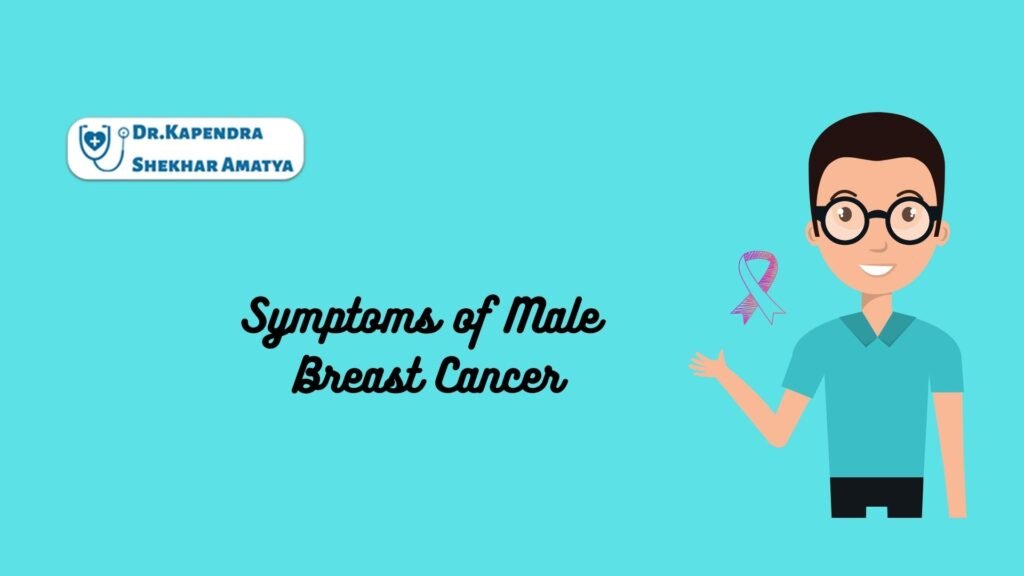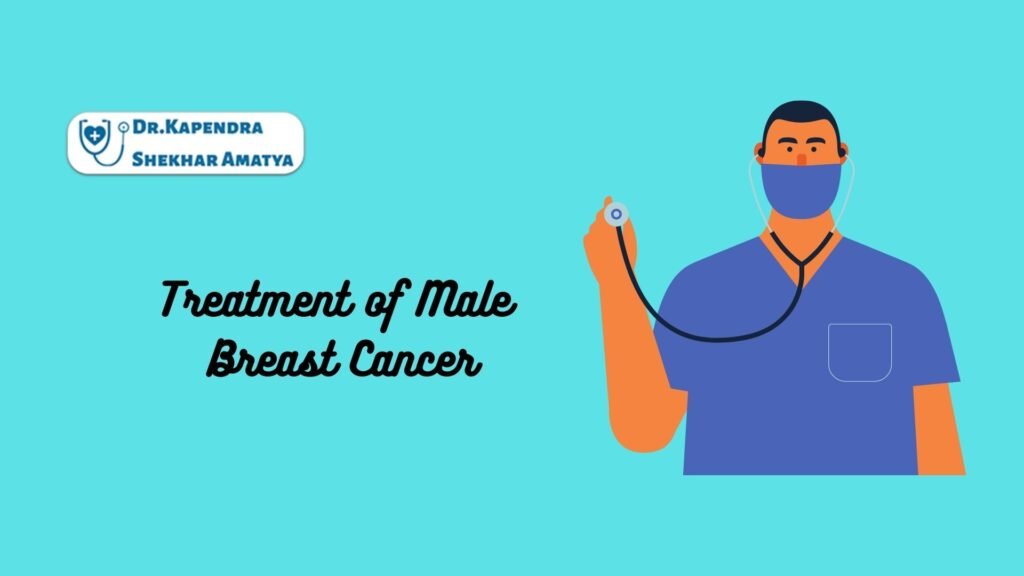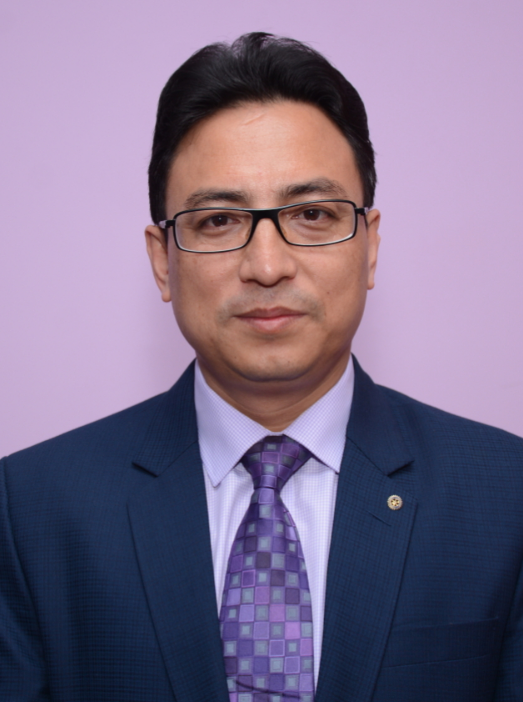Table of Contents
ToggleWomen are most likely to develop breast cancer, but men can also develop the disease. Men account for about 1 out of every 100 cases of breast cancer diagnosed. Male breast cancer are similar to female breast cancers.
• Invasive ductal carcinoma Initially, cancer cells grow inside the ducts, then they spread to other parts of the breast. The spread of cancer cells to other parts of the body is also possible with invasive cancer cells.
• Invasive lobular carcinoma It is believed that cancer cells begin in the lobules of the breast, and then spread to the nearby breast tissues. Besides spreading to other parts of the body, these cells can also be invasive.
• Ductal carcinoma in situ Invasive breast cancer may occur as a result of DCIS. Only the duct’s lining is affected by the cancerous cells; no other breast tissues have been affected.
Symptoms of Male Breast Cancer:

Men who have breast cancer typically develop a lump in their breasts and affected areas may also include the nipple and skin.
Breast lump:
It is common for cancerous breast lumps to:
• Only occurs in one breast
• The growths occur around or under the nipple
• No pain is felt
• Have a hard, rubbery feel
• Movements within the breast are not possible
• A bumpy feeling rather than smoothness
• Become larger over time It is not uncommon for lumps and swellings to be signs of cancer. Most of the time, they are caused by harmless things like enlarged male breast tissue, fatty lumps, or fluid-filled bumps. You can consult a GP if you suspect breast cancer and receive testing and scans.
Other symptoms:
Men with breast cancer may also show the following symptoms:
• An inward-facing nipple
• Nipple fluid streaked with blood, which may ooze out of the nipple
• Continual sores or rashes around the nipple
• Hardening, reddening, or swelling of the nipple or surrounding skin
• Several small bumps under the armpit cancer may cause further symptoms if it spreads to the bones, lungs, or liver.
Several symptoms can be experienced, including:
• Having a constant feeling of fatigue
• Bone pain or aches
• Breathing difficulties
• Sickness
• An itchy skin condition with skin and eyes yellow.
When to Consult a Breast Cancer Doctor?
Consult your doctor if you have:
• The presence of a lump in the breast
• Symptoms that may be concerning, such as nipple discharge
• Have family members with breast cancer (men or women) and are concerned about your chances.
It’s important to get your symptoms checked even if you don’t think you have cancer. Breast cancer tests and scans can be referred to your GP if necessary. Your GP may refer you to a genetic specialist if you do not show any symptoms of breast cancer but have a family history of the disease. Blood tests can be performed to check for inherited genes that increase cancer risk.
You can consult with your surgical oncologist to know more details about the condition. The breast cancer oncologist will then explain everything to you in detail. Also, the breast cancer treating doctor will help you in each phase of your treatment procedure. As per the top surgical oncologist in Nepal Dr. Kapendra Shekhar Amatya, it is best suggested to consult with your oncologist as soon as possible. It will hence help to get the best treatment in the given time.
Causes for Male Breast Cancer:
Male breast cancer is not known to be caused by any specific factor. Some breast cells divide rapidly in male breast cancer, causing the disease. During this process, accumulating cells form tumors that can spread to other parts of the body, such as lymph nodes and nearby tissues.
The origin of breast cancer in men:
Breast tissue is a natural part of every human being. Breast tissue consists of glands that produce milk and ducts that transport the milk to the nipples. When women reach puberty, their breast tissue begins to increase, while men do not. Men can, however, develop breast cancer due to a limited supply of breast tissue at birth.
Breast cancer risk genes inherited from parents:
Breast cancer risks are increased in some men due to abnormal genes inherited from their parents. Breast and prostate cancers are more likely to develop if you have mutations in certain genes, especially BRCA2. Your doctor should be informed if your family has a history of cancer. To find out if you carry genes that increase your risk of cancer, your doctor may recommend that you meet with a genetic counselor.
Possible Risk Factors for Male Breast Cancer:

Breast cancer is more likely to develop in men due to a variety of factors. Although these factors are important for predicting breast cancer in men, many do not have them.
Growing older:
As you get older, you are more likely to develop male breast cancer. Breast cancer is most commonly diagnosed in men over the age of 67. There is a possibility of breast cancer developing in young men as well.
Family history of breast cancer:
Having a close relative with breast cancer, especially a male relative, increases a man’s risk for breast cancer. Get all the information about your relative’s condition and know whether or not you’re at risk of having male breast cancer.
Genetic mutations:
Among men, certain genetic mutations are associated with an increased risk of breast cancer. Breast cancer is about a 1% risk for men who inherit the BRCA1 mutation over the course of their lifetime, compared to a 0.1% risk for men without such a mutation. There is a 7% to 8% chance of contracting cancer if a man inherits a BRCA2 mutation.
High estrogen levels:
Estrogen and testosterone can be thought of as female and male hormones, respectively. Despite what many people believe, both testosterone and estrogen are present at different levels in the bodies of men and women. In men, estrogen is found in smaller amounts than in women, but it is present in every man at some level. Male breast cancer is associated with higher estrogen levels. Estrogen levels can be high in men for a variety of reasons, including:
• Prostate cancer treatment with hormone therapy
• Transgender women taking hormone therapy
• Obesity or being overweight
• The liver’s ability to regulate hormone levels in the blood can be impaired by heavy drinking and liver disease
• A testicle that has not descended
• Testicles may be removed surgically
• Inflammation or swelling of the testicles
Radiation exposure:
Radiation therapy to the chest, such as for Hodgkin lymphoma treatment, increases breast cancer risk among men. Gather all the information about it and be well prepared before taking radiation therapy.
Diagnosis of Male Breast Cancer:
To diagnose cancer, doctors use a variety of tests. Tests are also performed to see if cancer has spread elsewhere in the body. This is known as metastasis. Additionally, doctors may conduct tests to determine which treatments are most effective.
Biopsies are the only sure way for doctors to determine whether a particular part of the body has cancer. Laboratory tests are performed on samples of tissue taken during a biopsy. An alternative test may be suggested if a biopsy is not possible. Breast cancer in men may be diagnosed by a physical examination as well as the following tests:
• Clinical breast examination Doctors will feel under the arms and breast tissue for lumps during this procedure.
• Diagnostic mammography Diagnostic mammograms are recommended by doctors if a lump or suspicious area is discovered.
• Ultrasound An ultrasound of the breast produces a picture of the breast tissue by using high-frequency sound waves. Usually, a cyst is not cancer, but a solid mass can be distinguished from a cyst that is filled with fluid.
• Nipple discharge examination Using a microscope, it is possible to examine the fluid from the nipple for cancer cells.
• Biopsy Under a microscope, a biopsy involves removing a small sample of tissue. Only a biopsy can confirm a cancer diagnosis if other tests indicate cancer is present.
Treatment of Male Breast Cancer:

Breast cancer is treated differently for men with different types of cancer. Trials are being conducted on some treatments, while others are already standard practice. Patients with cancer can benefit from treatment clinical trials by obtaining information on new treatments or improving current treatments. An improved treatment may become the standard treatment when clinical trials prove it to be superior to the standard treatment.
Some patients may be able to benefit from clinical trials. Modern cancer treatments are based on clinical trials that were conducted years ago. Participating in a clinical trial will allow patients to receive either standard treatment or a novel treatment that is yet to be developed.
Surgery in Nepal:
The most common treatment for breast cancer in men is a modified radical mastectomy, in which the entire cancerous breast is removed. It may involve the removal of the breast skin, the nipple, and the areola. There is also a removal of most lymph nodes under the arm.
Some men with breast cancer undergo breast-conserving surgery, in which the cancer is removed but the breast is left intact. Lumpectomies involve the removal of tumors and some normal tissue around them. Cancer cells that remain after surgery are killed with radiation therapy.
Chemotherapy in Nepal:
Chemotherapy stops cancer cells from growing by destroying or preventing them from dividing. The drugs in chemotherapy can reach cancer cells throughout the body when they are taken orally or injected.
Hormone therapy in Nepal:
In hormone therapy, cancer cells are prevented from growing by removing or blocking hormones. The body produces hormones, which are circulated through the bloodstream. Cancers can grow faster when hormones are present. To reduce the production of hormones or block their action, drugs, surgery, or radiation therapy are used when tests show that cancer cells have hormone-attaching sites.
Radiation therapy in Nepal:
To kill cancer cells or prevent their growth, radiation therapy uses high-energy x-rays or other kinds of radiation. By using an external machine, radiation is bombarded on cancer cells.
Targeted therapy in Nepal:
Cancer cells can be identified and attacked using targeted therapy using drugs or other substances. Normal cells are less likely to be damaged by targeted therapies than they are by chemotherapy and radiation. Inhibitors of tyrosine kinase, cyclin-dependent kinase, and mammalian targets of rapamycin are all effective at treating patients with breast cancer.
What is a Breast Cancer Surgery – Dr. Kapendra Shekhar Amatya

MS (NMC Regd.2902)
Head of the Department, Sr.Consultant Surgical Oncologist at Nepal Cancer Hospital and Research Center
Director: Breast Cancer Program
Interest: Breast Cancer Surgery, Gastro Intestinal Cancer Surgery (Stomach and Colo-Rectal Cancer)



2 thoughts on “Male Breast Cancer in Nepal”